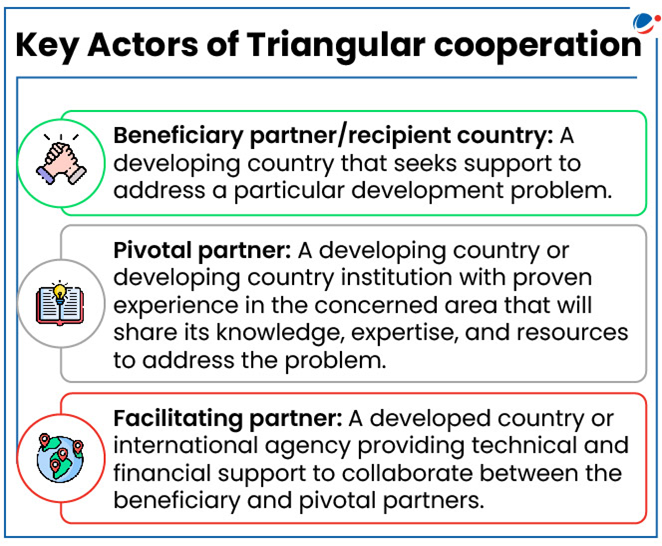A recent report by the OECD and the Islamic Development Bank stresses that triangular partnerships can effectively win influence in a divided and conflicted world.

About Triangular Partnership or Triangular Cooperation
- Definition: Triangular cooperation refers to projects and initiatives combining the comparative advantages of traditional donors and southern countries to share knowledge and address development concerns in developing countries.
- Key Advantages
- Enables more efficient development delivery through resource pooling, co-creation, and the best available technology
- Builds the capacity of developing countries as providers of development cooperation
- Contributes to the SDGs
- Global Trends
- Between 2000 and 2022, 199 countries and 85 organizations engaged in over 1,000 triangular projects (OECD estimate).
- 68% of these projects had budgets under $1 million, providing low-cost, flexible development solutions ensuring cost-effective, flexible solutions.
- India's Participation in Triangular Cooperation
- Ranks 8th among top 10 countries in triangular partnerships.
- Key India-led Triangular Partnerships
- India and Japan signed a memorandum of cooperation with Sri Lanka to develop the East Container Terminal (ECT) in 2019.
- India and the US signed the 'Statement of Guiding Principles on Triangular Cooperation for Global Development' (SGP) and its validity extended up-to 2026.
Reasons for Resurgence of Triangular Partnerships
- Failure of Western Aid Model: By the early 2000s, the traditional charity-based development aid system with strict donor-recipient hierarchies lost credibility, prompting calls for reform.
- Rise of Emerging Donors: Countries like China, India, and Brazil introduced development programs based on equal partnerships and mutual benefit, gaining support from recipient nations.
- China's Influence: China's growing footprint, particularly in the infrastructure sector in Africa, the Association of Southeast Asian Nations (ASEAN), and the South Pacific, has made it imperative for the G7 countries to engage with India, a democratic country with shared values.
- Geopolitical rivalries: Conflicts within and between nations are exacerbating economic instability demanding new model of development
Challenges of Triangular Partnerships
- Power Imbalance and Trust Issues: Donor countries' priorities and agendas may often overshadow recipient countries' interests.
- For e.g., some developed countries prefer to work with only investment-grade countries in Africa, not the Heavily Indebted Poor Countries (HIPCs).
- Hesitance of recipient countries: Developing countries find it cumbersome to adhere to all the norms and standards required by developed country partners.
- For e.g., most recipient countries, particularly in Africa, find it cumbersome to abide by the European notions of sustainability, and their required norms and standards.
- Implementation Challenges: Partner countries often differ over procurement rules, financial structure, and legal framework.
- For e.g., Under the Indian lines of credit programme, 75 % of the inputs are procured from India, and Indian companies implement the projects. This often leads to disagreements with partner countries, which prefer prioritizing their own companies.
- Limited scale and scope: Most of these trilateral partnership initiatives adopt a project-based approach, which the Paris Declaration on Aid Effectiveness warns may result in a disconnect with broader development goals.
Way Ahead for Strengthening Triangular Partnerships
- Promoting Inclusive Partnerships: Ensure recipient nations have a say in decision-making to build trust. Encourage mutual learning to create practical and feasible guidelines.
- Simplifying Standards for Recipient Countries: Adapt sustainability and regulatory norms to local contexts rather than imposing one-size-fits-all European standards.
- Enhancing Flexibility in Implementation: Align procurement policies to balance donor interests with local economic priorities.
- Scaling Up and Aligning with Long-Term Development Goals: Move beyond project-based approaches to integrate triangular cooperation with national and regional development strategies.
- Leverage international frameworks like the Paris Declaration on Aid Effectiveness to ensure sustainable impact.
Conclusion
By fostering equity, adaptability, and long-term vision, triangular cooperation can become a more effective and mutually beneficial development model.



